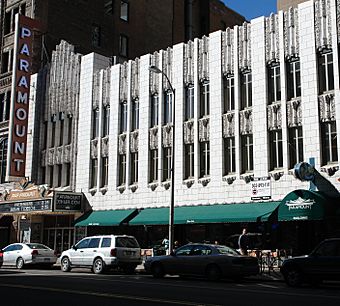Paramount Theatre (Denver) facts for kids
Quick facts for kids |
|
|
Paramount Theatre
|
|
 |
|
| Location | Denver, CO |
|---|---|
| Built | 1930 |
| Architect | Temple H. Buell |
| Architectural style | Art Deco |
| NRHP reference No. | 80000893 |
| Added to NRHP | November 21, 1980 |
The Paramount Theatre is a famous concert hall in Denver, Colorado. It's located on Glenarm Place, close to Denver's popular 16th Street Mall. This theater can hold 1,870 people. It's a favorite spot for big music acts who want to play in a smaller, more personal setting. The building was added to the National Register of Historic Places in 1980.
Contents
History of the Paramount Theatre
Opening as a Movie Palace
The Paramount Theatre first opened its doors in 1930. It started as a movie theater. It was part of the Paramount-Publix Theatre Circuit. This was the movie showing part of Paramount Pictures. The theater itself was designed by a Chicago company called Rapp and Rapp. Vincent Mondo did the decorations. Louis Grell of Chicago painted the murals. The main entrance used to be at 519 16th Street. It was cut through an existing office building.
Building Design and Style
The building next door has three stories. It used to be the theater's second entrance. Now, it's the main entrance on Glenarm Place. This part was designed by a local architect named Temple H. Buell. Buell's design is a modern take on the Gothic style. It uses Art Deco elements. The building is mostly made of cast concrete and white terra cotta.
From Movies to Live Shows
For many years, the Paramount was a top movie theater. It was one of the best in the Rocky Mountain region. But over time, fewer people went to big movie theaters. This happened as people moved to new suburban areas. By 1978, it was the last "movie palace" left in Denver. A movie palace is a very grand and fancy movie theater.
The Paramount started hosting live shows. In October 1978, it hosted an opera called Madama Butterfly. The theater has changed and survived. Now, it hosts many concerts and performances. The theater was added to the National Register of Historic Places in 1980. The city of Denver named it a historic landmark in 1988. Eight years later, the entertainer Sinbad performed his HBO comedy special there. In 2002, Kroenke Sports & Entertainment bought the Paramount. They also bought the building next door.
The Famous Wurlitzer Organ
A Special Musical Instrument
The Paramount Theatre has a very special musical instrument. It is one of only two "twin-console" Wurlitzer theatre organs left in the United States. The other one is in New York City, at Radio City Music Hall. A theatre organ is a large pipe organ. It was made to play music for silent movies. It can also make sound effects.
Features of the Organ
The Paramount's organ is very big. It has four keyboards, called manuals. It also has twenty "ranks" of pipes. A rank is a set of pipes that make a certain sound. In total, it has over 1600 pipes! This makes it one of the largest organs ever put in the Rocky Mountain region. It is a Publix#1 style Wurlitzer. This type was designed by a famous organist named Jesse Crawford. It was installed in the theater on July 23, 1930.
Recent Updates to the Organ
After it was first installed, the organ needed a special sound. This sound was called an English Post Horn. So, an original part called the Vox Humana was removed. It was stored in the building. A Post Horn was bought and installed instead.
Recently, Bill Brown learned about the stored Vox pipes. He owned the Phoenix Organ Stop pizza parlors. He donated a special pipe chest. This chest was for the "silent" Vox rank. The Rocky Mountain chapter of the American Theatre Organ Society takes care of the instrument. They completed the installation in 2012. Now, the second Vox is playing again. This means the organ now has twenty-one ranks of pipes. The second console is a Wurlitzer three-manual shell. It is a bit smaller than the main console. The Wurlitzer organ is a popular part of Denver's cultural tours.
See also
 In Spanish: Teatro Paramount (Denver) para niños
In Spanish: Teatro Paramount (Denver) para niños

